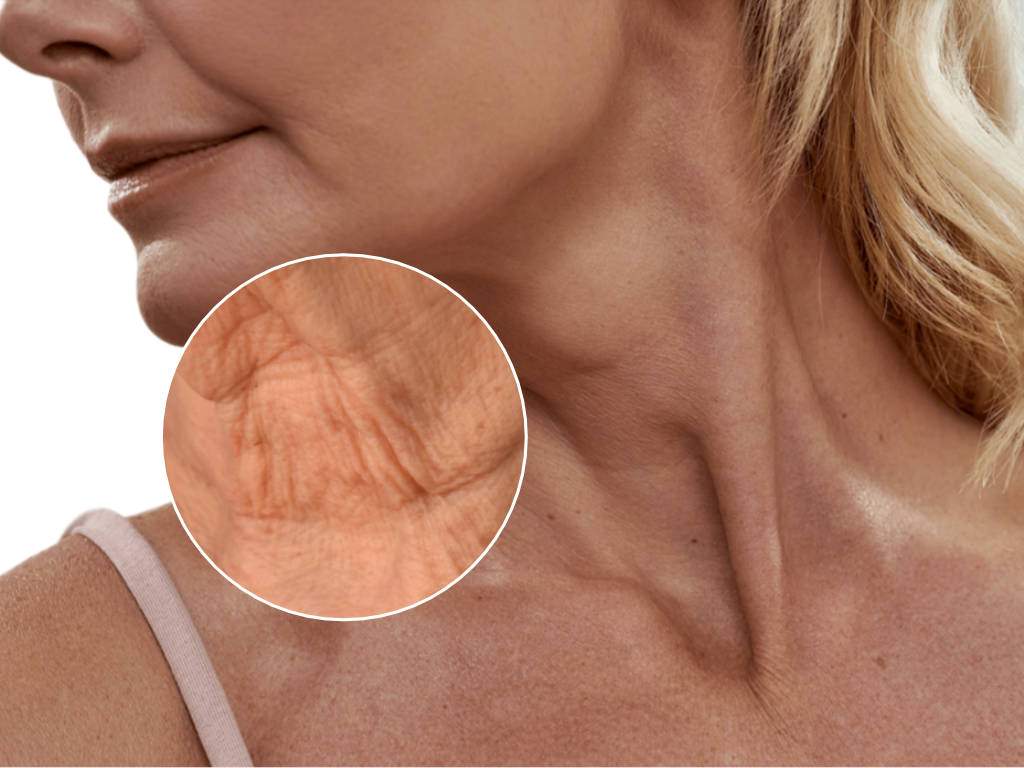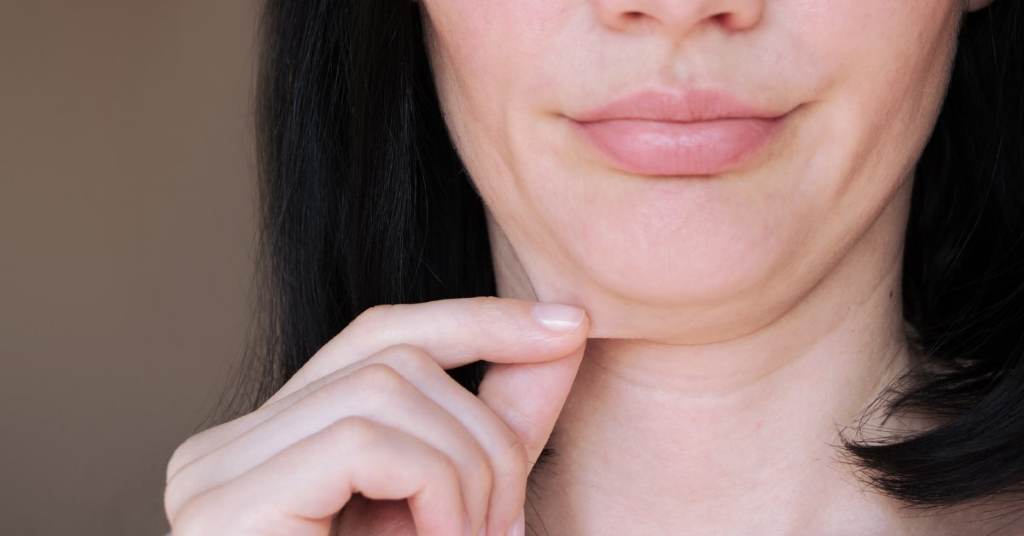Imagine this. You glance in the mirror one morning. Your face looks fresh after that new skincare routine. But then you spot them. Those stubborn horizontal lines across your neck. They seem to appear out of nowhere. Yet they tie directly to your daily habit of scrolling through emails on your phone. Welcome to the world of tech neck wrinkles. This modern issue stems from hours spent hunching over devices. It creates creases that make you look older than you feel. According to a 2024 study from the National Institutes of Health, nearly half of U.S. adults spend 5 to 6 hours daily on smartphones.
That adds up to over 2,000 hours a year. Such patterns accelerate skin aging. In fact, the American Academy of Dermatology reports that poor posture from device use contributes to early wrinkle formation in 60% of young adults under 35. But here’s the good news. You can fight back. This article breaks it all down. We’ll explore causes, signs, and smart ways to prevent and treat these lines. By the end, you’ll have tools to reclaim smooth, confident skin. Let’s dive in.
Understanding Tech Neck Wrinkles
Tech neck wrinkles go beyond simple aging. They form from repeated strain on delicate neck skin. When you tilt your head down to check texts or emails, gravity pulls harder on your skin. This action folds the thin layer repeatedly. Over time, those folds turn permanent. Unlike facial lines, neck skin has fewer oil glands. It struggles to bounce back. As a result, creases deepen faster.
Moreover, this condition often starts young. A 2025 Baylor College of Medicine report highlights how millennials face these lines earlier due to device habits. You might notice them in your 20s or 30s. But awareness helps. Recognizing the pattern early lets you act. For instance, think of Sarah, a 28-year-old graphic designer. She ignored her neck creases at first. Then she connected them to long laptop sessions. Once she adjusted, improvements followed quickly.
Additionally, tech neck affects more than appearance. It links to overall posture health. Doctors now call it text neck syndrome in medical circles. This term captures the broader impact. However, focusing on wrinkles brings us back to skin science. Collagen, the protein that keeps skin firm, breaks down under strain. Without it, elasticity fades. Thus, understanding this foundation sets the stage for solutions.

The Science Behind the Lines
Skin on your neck measures just 2 millimeters thick. Compare that to 3 millimeters on your cheeks. Such thinness makes it vulnerable. Repeated flexion stretches fibers beneath the surface. Fibroblasts, cells that produce collagen, get overworked. Eventually, they slow production. A 2024 PubMed study on neck rejuvenation confirms this. Researchers found that forward head posture reduces collagen by up to 20% in frequent device users.
Furthermore, inflammation plays a role. Constant bending irritates muscles and tissues. This response speeds wrinkle formation. Yet, it’s not all doom. Your body can repair with the right habits. For example, gentle stretches restore blood flow. They encourage healing at a cellular level. Therefore, blending science with daily tweaks yields real results.
Causes of Tech Neck Wrinkles
Multiple factors fuel tech neck wrinkles. Device use tops the list. But others sneak in too. Let’s unpack them one by one. Awareness empowers change.
First, prolonged screen time stands out. Adults average 7 hours daily on phones, per 2025 global data. Each glance down adds pressure. Your head weighs 10 pounds upright. Tilt it forward 60 degrees, and it feels like 60 pounds. This force creases skin repeatedly.
Second, poor posture amplifies the issue. Slouching shortens neck muscles. They pull skin tighter over time. A chiropractic analysis from 2024 notes that forward neck creep weakens back support. Consequently, lines etch deeper.
Third, natural aging contributes. After 25, collagen drops 1% yearly. Neck skin, exposed and thin, shows it first. However, tech habits hasten this clock.
Additionally, sun exposure worsens everything. UV rays break down elastin. A London Dermatology Clinic study from 2025 links photoaging to 80% of visible neck lines. Without protection, wrinkles multiply.
Finally, sleep positions matter. Piling pillows bends your neck overnight. This mimics daytime strain. One case study described a woman who fixed lines by switching to a single low pillow. Small shifts like that prevent buildup.
How Daily Habits Build Creases
Consider your routine. Mornings start with coffee and news feeds. Afternoons bring video calls. Evenings end with bedtime scrolling. Each moment adds folds. Over months, they stick. But tracking time reveals patterns. Apps now log screen hours. Use one to spot peaks. Then, set limits. For instance, batch check emails twice daily. This cuts mindless tilts.
Moreover, environmental factors layer on. Dry air from offices saps moisture. Dehydrated skin creases easier. Thus, pairing habit changes with hydration fights back effectively. Discover Why does heat extraction work in carpet cleaning?
Symptoms and Signs to Watch For
Spotting tech neck wrinkles early changes the game. They don’t announce themselves loudly. Instead, subtle clues build. Horizontal bands across the neck signal trouble. These rings, often three or four, run parallel to your collarbone. You see them when tilting your chin up.
Neck pain accompanies many cases. A dull ache spreads to shoulders. Headaches follow from muscle tension. In severe instances, numbness tingles down arms. A 2025 scoping review in the Journal of Clinical Medicine found 50% to 84% of smartphone users report such discomfort.
Skin texture shifts too. Dryness leads to flakiness. Sagging appears under the jaw. Fine lines branch into deeper grooves. If you press the skin, it snaps back slower than on your face.
Furthermore, posture changes visually. Your head juts forward. This “forward head posture” ages your profile. Friends might comment on it casually. Listen to those hints.
When to Seek Professional Insight
Ignore mild signs at your peril. But if pain persists, consult a doctor. Dermatologists check for underlying issues. Physical therapists assess alignment. Early visits prevent escalation. Remember, self-awareness starts the fix.
Prevention Strategies for Smoother Neck Skin
Prevention beats cure every time. Start with posture tweaks. Hold devices at eye level. Use stands or risers for phones and laptops. This keeps your neck neutral. Set reminders every 30 minutes to sit tall. Over weeks, it becomes habit.
Next, incorporate stretches. Tilt your head side to side gently. Hold for 10 seconds each way. Roll shoulders back in circles. Do this routine twice daily. A Baylor expert recommends it for muscle balance.
Skincare routines protect too. Apply broad-spectrum SPF 30+ to your neck daily. Antioxidants like vitamin C fight free radicals. Moisturize with hyaluronic acid for plumpness. Retinol creams boost collagen overnight. Layer them smoothly for best results.
Limit screen time wisely. Follow the 20-20-20 rule. Every 20 minutes, look 20 feet away for 20 seconds. Apps enforce breaks. Walk during calls to move freely.
Sleep smartly. Choose a supportive pillow that aligns your spine. Back sleeping avoids bends. Silk cases reduce friction on skin.
Daily Habits That Make a Difference
Build a checklist. Morning: Sunscreen application. Midday: Posture check. Evening: Stretch session. Track progress with photos. Monthly comparisons motivate.
Moreover, strengthen your core. Planks and yoga poses support neck health. Join a class for accountability. Friends can partner up for mutual reminders.
Treatment Options for Existing Wrinkles
Once lines form, treatments help. Start non-invasive. Topical retinoids smooth texture over months. They stimulate cell turnover.
For quicker wins, consider ultrasound therapy like Sofwave. It tightens skin without downtime. Sessions last 30 minutes. Results build over three months.
Injectables fill creases effectively. Hyaluronic acid plumps lines instantly. Botox relaxes muscles that pull skin. A 2025 PubMed trial showed 70% improvement in neck appearance after combined use.
Laser resurfacing evens tone. Fractional lasers zap damaged layers. New skin grows smoother. Pair with peels for deeper renewal.
Microneedling with radiofrequency adds collagen. Tiny pricks trigger healing. Sessions space four weeks apart. Patients report firmer necks after three rounds.
Choosing the Right Approach
Tailor choices to your needs. Mild lines suit topicals. Deeper ones need pros. Consult board-certified experts. They map personalized plans.
Case in point: Emily, 35, battled tech lines from remote work. She combined stretches with fillers. Six months later, her neck looked years younger. Stories like hers inspire action.
Lifestyle Changes to Erase Tech Neck
Beyond treatments, lifestyle shifts sustain gains. Hydrate inside out. Drink 8 glasses of water daily. It keeps skin supple.
Eat collagen-rich foods. Bone broth, citrus, and berries aid production. Omega-3s from fish reduce inflammation.
Exercise regularly. Neck-specific yoga flows realign. Cardio boosts circulation for glow.
Stress management counts. Meditation eases tension that tightens muscles. Apps guide short sessions.
Finally, audit your workspace. Ergonomic chairs support spines. Blue light filters cut eye strain, indirectly aiding posture.
Building Long-Term Habits
Commit gradually. Pick one change weekly. Track in a journal. Celebrate milestones. Community forums share tips and encouragement.
As you integrate these, notice shifts. Energy rises. Confidence grows. Your neck reflects inner vitality.
Conclusion
Tech neck wrinkles sneak up from screen habits and posture slips. They cause horizontal lines, pain, and early aging signs. Yet, stats show hope. With 90% of adults using smartphones, prevention reaches everyone. Key takeaways include eye-level devices, daily SPF, stretches, and targeted skincare. Treatments like fillers and lasers reverse damage fast. Lifestyle tweaks seal the deal. You hold the power to smooth your skin. Start today. Elevate your phone right now. Apply moisturizer tonight. Feel the difference build. Your future self will thank you. Take that first step toward a wrinkle-free neck. Share your progress in comments below.
FAQs
What Exactly Causes Tech Neck Wrinkles?
Tech neck wrinkles arise from repeated downward head tilts during device use. This strains thin neck skin, breaking collagen over time. Poor posture and sun exposure speed the process. A 2024 study links 5+ hours of daily screen time to 20% faster line formation.
How Can I Prevent Tech Neck Lines at Home?
Raise screens to eye level daily. Stretch neck muscles twice a day. Use SPF on your neck every morning. Limit scrolling to under 2 hours recreationally. These steps cut crease risk by 50%, per dermatology experts.
Are There Quick Fixes for Neck Wrinkles from Phones?
Yes, hyaluronic fillers plump lines in one session. Botox softens muscle pull. Results last 6 to 12 months. Combine with topicals for lasting smoothness.
Does Sleep Affect Tech Neck Wrinkles?
Absolutely. High pillows bend your neck overnight, mimicking daytime strain. Opt for a low, contoured pillow. Back sleeping aligns your spine best, reducing morning creases.
When Should I See a Doctor for Tech Neck?
Seek help if pain lasts over two weeks or numbness occurs. Dermatologists diagnose early. They rule out issues like herniated discs. Early intervention prevents worsening.
References
- Baylor College of Medicine Blog: https://blogs.bcm.edu/2025/02/13/avoid-strain-and-wrinkles-caused-by-tech-neck/
- PubMed Study on Neck Rejuvenation: https://pubmed.ncbi.nlm.nih.gov/36374589/
- Journal of Clinical Medicine Scoping Review: https://pmc.ncbi.nlm.nih.gov/articles/PMC11856789/
- American Academy of Dermatology Reports: https://www.aad.org/public/everyday-care/skin-care-secrets/anti-aging/reduce-premature-aging-skin (general reference for aging stats)

